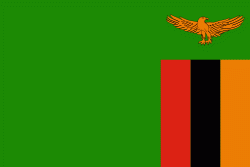Mwense District (Mwense District)
Its top tourist attraction is the Mumbuluma falls, which is a set of waterfalls and are a national monument of Zambia. The Falls is made up of two waterfalls occurring in succession, an upper and lower falls.
The district is also home to the Mambilima falls, which is a series of rapids in the Luapula river, about 50 km from the Mumbuluma falls on the boarder between Zambia and the Democratic Republic of Congo.
Map - Mwense District (Mwense District)
Map
Country - Zambia
 |
 |
| Flag of Zambia | |
The region was affected by the Bantu expansion of the 13th century. Following the arrival of European explorers in the 18th century, the British colonised the region into the British protectorates of Barotseland-North-Western Rhodesia and North-Eastern Rhodesia comprising 73 tribes, towards the end of the 19th century. These were merged in 1911 to form Northern Rhodesia. For most of the colonial period, Zambia was governed by an administration appointed from London with the advice of the British South Africa Company. On 24 October 1964, Zambia became independent of the United Kingdom and prime minister Kenneth Kaunda became the inaugural president. From 1972 to 1991 Zambia was a one-party state with the United National Independence Party as the sole legal political party under the motto "One Zambia, One Nation" coined by Kaunda. Kaunda was succeeded by Frederick Chiluba of the social-democratic Movement for Multi-Party Democracy in 1991, beginning a period of government decentralisation.
Currency / Language
| ISO | Currency | Symbol | Significant figures |
|---|---|---|---|
| ZMW | Zambian kwacha | ZK | 2 |
| ISO | Language |
|---|---|
| NY | Chichewa language |
| EN | English language |















